7.0 Central and Eastern Europe
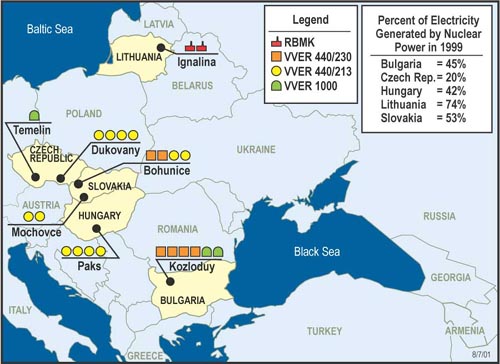 The Central and Eastern European nuclear power plants participating in the cooperative effort to improve nuclear safety. |
Reactor Types in Central and Eastern Europe
|
The United States is working with five countries in Central and Eastern Europe to reduce risks at Soviet-designed reactors. Projects are under way at 23 reactors in the following countries:
Six operating reactors at the Kozloduy nuclear power plant provided 47 percent of the electricity generated in Bulgaria in 1999. Four of the reactors are VVER-440/230s; the other two are VVER-1000s. Program activities cover the following areas:
- Configuration Management
- Personnel Training
- Emergency Operating Instructions
- Safety Analysis Capabilities
- Seismic Assessments
- Thermal Imaging
- Fire Safety
- Emergency Power
- Conduct of Operations
7.1.1 Configuration Management
A configuration management system ensures that a plant's physical configuration is in keeping with its safety design basis, which is the foundation for overall plant safety.
With support from U.S. experts, Kozloduy plant specialists created a configuration management system, and Kozloduy staff members implemented the system at the shore pumping station, which supplies cooling water essential for safe operation of all six Kozloduy reactors.
In 1998, the United States delivered equipment to produce permanent vinyl labels for safety-related equipment and controls. The United States also delivered computers for use in configuration management, and Risk Engineering Limited, a Bulgarian contractor, completed the development of configuration management software. American Technologies Incorporated provided technical support for this activity.
Work at the pilot facility provided Kozloduy personnel the expertise needed to use configuration management throughout the plant. In 1999, specialists from the United States and Kozloduy nuclear power plant performed an assessment of configuration management at the nuclear units. The purpose of the assessment was to prioritize work needed to transfer improved methodology from the pilot facility to the nuclear units. Kozloduy staff members have assumed responsibility for further work.
|
"The management and personnel have accepted the configuration management and are working to complete it. And I can assure you, they are receiving top management support and assistance. Approaching the end of the project, they see the benefits and are working with even more willingness...... At the same time, the management of Electroproduction 2 has declared that they are going to develop and implement configuration management for Units 5 and 6. This implementation is not part of the pilot project [supported by the United States]...... The manager of Electroproduction 2, Mr. Mitko Yankov, committed to ensure all necessary human and material resources for the successful completion of the project." -Krassimir Nikolov |
Specialists from the United States and the Kozloduy training center are working together to improve training for plant personnel.
In 1996, Kozloduy specialists participated in a course on the Systematic Approach
to Training. This approach provides a framework for identifying training needs,
analyzing jobs, developing course materials, and combining classroom and hands-on
instruction. Specialists from U.S.-based General Physics Corporation conducted
the course.
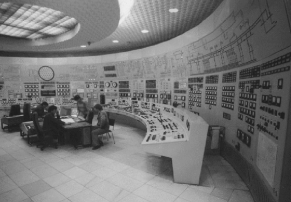 In 1998, Kozloduy instructors presented a pilot for control room operators, like the operators show here in the control room of Unit 1. |
In 1997, US training specialists conducted instructor training courses at Kozloduy, provided basic materials for the training center, and conducted a seminar for senior managers on the Systematic Approach to Training. In 1998, with support from General Physics Corporation staff, Kozloduy instructors presented a pilot course for control room operators. A US training expert conducted a course in management and supervisory skills for upper-level managers at Kozloduy. A second course for upper-level managers covered organizational safety culture. Also in 1998, US and Kozloduy training specialists surveyed a random sample of plant employees regarding the plant's organizational culture to assess training accomplishments and needs. Kozloduy instructors worked with US experts from Sonalysts Corporation to develop and implement a maintenance-training course in 1999. |
Work in Progress
Kozloduy and US specialists began plans to develop specialized training courses to support implementation of new symptom-based emergency operating instructions. Training specialists began developing this training in December 2000.
7.1.3 Emergency Operating Instructions
Bulgarian specialists have drafted a complete set of symptom-based emergency operating instructions for Kozloduy's VVER-440/230 and VVER-1000 reactors. Such instructions enable operators to correct abnormal conditions even before determining the cause.
US experts trained Bulgarian specialists in the methodology for developing symptom-based emergency operating instructions. US experts are providing training and support for Bulgarian specialists who have drafted scenarios and are conducting detailed analysis to verify that the emergency operating instructions will mitigate accidents (validation).
Emergency operating instructions for the VVER-1000 Units 5 and 6 have been technically validated and work continues for the VVER-440/230 instructions. The technical validation effort has identified additional accident conditions for which mitigation strategies need to be developed or existing strategies modified and technically validated. This work will be completed in 2001.
7.1.4 Safety Analysis Capabilities
The United States is working with specialists from the Kozloduy plant and the Bulgarian nuclear regulatory authority to improve their ability to perform and review safety analyses at Kozloduy.
Kozloduy analysts, using the RELAP5 computer code, have created models of the VVER-440/230 and VVER-1000 reactors at the plant. Typically, analysts model a plant's thermal-hydraulic system and then simulate severe accident scenarios. Using the accident simulations, they test emergency operating instructions. The analysts now have developed and are working to validate RELAP5 models and analyze accident scenarios.
In 1998, the United States delivered computer hardware and software for use in Kozloduy's safety analyses. US personnel provided training on technical basis calculations. Participating were personnel from Kozloduy, the Bulgarian Academy of Sciences, and Energoproekt. Ukrainian personnel also participated.
In November 1998, Kozloduy specialists began augmenting their quality assurance guidelines for the continued development of RELAP5 models.
The U.S.-supported work for Units 1 through 4 (the VVER-440/230s) has been completed. In 2000, Bulgarian experts completed analyses for the VVER-440/230 and VVER-1000 units for validation of the RELAP5 models. In addition, graphical displays of the RELAP5 models have been developed for use as part of a Nuclear Plant Analyzer.
In December 1996, US and Bulgarian engineers completed a seismic assessment of the building that houses electrical equipment for reactor Units 5 and 6. The study used a computer model to predict how the building's equipment would respond during earthquakes. The study showed that some structural supports could fail, potentially interrupting electrical service at the plant.
The team provided detailed design recommendations to strengthen the structural
supports and anchor the equipment. Kozloduy managers have implemented some of
these design upgrades and plan to include others in their plant modernization
program.
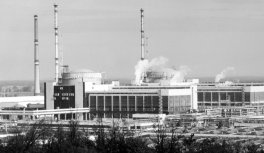 Kozloduy nuclear power plant, Unit 5 and 6. The plant is
implementing
Kozloduy nuclear power plant, Unit 5 and 6. The plant is
implementing
seismic upgrades based on an assessment by U.S. and Bulgarian specialists.
In 1997, US and Bulgarian specialists also performed a detailed seismic assessment of the essential service-water system and spray ponds that provide cooling for safety-related equipment outside the reactor containment areas.
The specialists recommended measures to reduce these systems' seismic vulnerability. In 1998, Kozloduy managers defined upgrades to the service-water system that will be included in their plant modernization program.
Representatives of Risk Engineering Limited, U.S.-based Parsons Power Group, and Pacific Northwest National Laboratory conducted the study in cooperation with Kozloduy plant staff.
In August 1996, the United States delivered thermal imaging equipment to check for hot spots in Kozloduy's electrical and mechanical systems. Some of the Kozloduy reactors had experienced unnecessary trips, or sudden shutdowns, caused by electrical faults. A breakdown of insulation or a faulty contact in a junction box can produce hot spots, overheat the circuits, and cause loss of power to equipment.
The thermal imaging equipment provided by the United States identifies hot
spots so that electrical repairs can be made before system reliability becomes
a problem. U.S.-based Inframetrics conducted hands-on training in the use of
the equipment.
 |
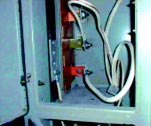 |
|
The infrared camera clearly shows
hot spots in this electrical junction (left) that are not visible otherwise
(right). The equipment is being used at the Kozloduy plant.
|
|
Along with the thermal imaging hardware, the United States provided software to analyze the images. To acquire this proprietary software at a reduced price, the United States purchased a one-year membership for Kozloduy in the Nuclear Maintenance Activity Center. The center, a subsidiary of the Electric Power Research Institute in the United States, provides maintenance training for US utilities. Experts from the Nuclear Maintenance Activity Center trained Kozloduy specialists to use the software.
The United States delivered fire-safety equipment to Kozloduy in 1994. Included were two fire trucks, firefighting equipment, protective suits, communications equipment, and radiation monitoring dosimeters.
In 1994, the United States provided a 1000-kilowatt diesel generator to provide backup power for key reactor safety systems.
Soviet-designed plants have developed procedures for improved management and operational controls. In 1993, a working group began drafting guidelines for 16 procedures. The group was composed of representatives from host plants, US industry, the Institute of Nuclear Power Operations, and the Department of Energy.
Using the guidelines, Kozloduy staff developed and implemented 16 site-specific procedures. The World Association of Nuclear Operators monitors progress in implementing the procedures at Soviet-designed plants and facilitates communication among the plants about lessons learned.
^top
Four operating reactors at the Dukovany nuclear power plant provided 21 percent of the electricity generated in the Czech Republic in 1999. All four reactors are VVER-440/213s. Program activities cover the following areas:
- Human Reliability Analysis
- Risk Advisory System
- Probabilistic Risk Assessment
- Information Exchanges
- Conduct of Operations
- Maintenance Database
In October 2000, Czech Republic utility, CEZ, initiated operation of Temelin Unit 1, a VVER-1000 reactor. CEZ expected to begin selling electricity produced at Temelin in late December 2000 or early January 2001. The utility also plans to continue construction of Temelin Unit 2 and targets early 2002 for completion of that reactor. Significant upgrades were made to Temelin Unit 1 to meet international safety standards, including the addition of western-style instrumentation and control systems and improved physical separation of major safety equipment.
7.2.1 Human Reliability Analysis
With support from US and Hungarian analysts, Czech analysts are gathering data on the reliability of reactor operators' decisions. To gather the data, staff members from Dukovany plant and the Czech Republic's Nuclear Research Institute are monitoring operators' actions while they train on a full-scope simulator at Slovakia's Trnava training center. During the training, operators respond to event scenarios developed for the plant's probabilistic risk analysis. Czech specialists will use the simulator data to refine the probabilistic analysis. The project began in 1998 and was completed in 1999.
With US support, Hungarian analysts completed a similar project at the Paks nuclear power plant in 1996. Paks and Hungarian Institute for Electric Power Research (VEIKI), a Hungarian organization, agreed in 1998 to transfer to the Czech Republic techniques for studying human reliability. Under the agreement with the Czech Nuclear Research Institute, VEIKI consulted with Institute personnel and Dukovany plant staff to modify their methodology and procedures.
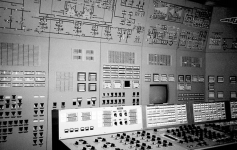 Czech
analysts used the full-scope simulator at the Trnava training center in
Czech
analysts used the full-scope simulator at the Trnava training center in
Slovakia to study the reliability of reactor operator decision-making at the
Dukovany plant.
With US funding, Scientech staff trained Dukovany staff in 1999 to use a software-based risk advisory system. Dukovany staff use the system to evaluate how the unavailability of certain plant components would affect safety. They can determine, for example, the risk to the plant if a cooling-system pump was out of service.
Dukovany staff members already have created a computer model of the plant's safety-related systems as part of a probabilistic risk assessment. By coupling this model with Scientech's SAFETY MONITOR software, staff can quantify the risk posed by the unavailability of each component. Maintenance staff will use the results to plan preventive maintenance so workers monitor more frequently the components that pose the highest risk.
7.2.3 Probabilistic Risk Assessment
In April 1998, US and Czech analysts completed a Level 2 probabilistic risk
assessment that evaluated the effectiveness of Dukovany's systems for confining
radioactive materials. Czech analysts will determine which containment risks
identified by the assessment are most significant and recommend follow-up work.
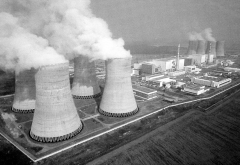 Dukovany nuclear power plant. With U.S. funding,
Dukovany nuclear power plant. With U.S. funding,
Scientech experts trained Dukovany personnel in 1999 to use a risk advisory
software program.
In 1994, US and Czech analysts completed a Level 1 probabilistic risk assessment, which quantified the risks of core damage from accident-initiating events. Dukovany staff modified the plant's operating requirements to reduce the risks identified in the analysis.
Personnel from the Czech Nuclear Research Institute did the assessment, with support from Brookhaven National Laboratory and Science Applications International Corporation.
The United States has sponsored international forums and workshops for exchanging information on in-depth safety assessments at Soviet-designed reactors. The International Atomic Energy Agency and the Swedish International Project on Nuclear Safety also have supported this effort.
Five forums focusing on analytical methods and computational tools for conducting assessments have been held. The first forum was in September 1996 in Obninsk, Russia. Representatives of 10 Soviet-designed nuclear power plants were among the 75 specialists attending from around the world. Forums have continued each year in Obninsk, in September 1997 and in October 1998, 1999, and 2000. The international forums now host more than 100 participants from a dozen countries.
Two smaller workshops have focused on probabilistic safety assessments at VVER reactors. The Czech Republic hosted the first of these in 1996. The workshop enabled participants to discuss such issues as loss-of-coolant accident frequencies and component reliability data. The participants-from Ukraine, Russia, the Czech Republic, Hungary, and Slovakia-requested a follow-up session, which took place in 1997 in Slovakia.
Soviet-designed plants have developed procedures for improved management and operational controls. Beginning in 1993, a working group drafted guidelines for 16 procedures. The group was composed of representatives from host plants, US industry, the Institute of Nuclear Power Operations, and the Department of Energy.
Using the guidelines, Dukovany staff developed and implemented 16 site-specific procedures. The World Association of Nuclear Operators monitors progress in implementing the procedures at Soviet-designed plants and facilitates communication of lessons learned.
In March 1995, a U.S.-Czech team completed a plant maintenance database that includes calculations of how long plant components will be out of operation because of maintenance work. The calculations help staff plan outages and maintenance work and also assist in predicting when the plant will be available to produce power.
^top
Four operating reactors at the Paks nuclear power plant provided 38 percent of the electricity generated in Hungary in 1999. All four reactors are VVER-440/213s. Program activities cover the following areas:
- Human Reliability Analysis
- Safety Analysis Capability
- Accident Localization System Improvements
- Thermal-Hydraulics Code
- Conduct of Operations
7.3.1 Human Reliability Analysis
US experts worked with Hungarian specialists to analyze the reliability of reactor operator decision-making at Paks. The specialists analyzed data on operator actions.
With US support, Hungarian specialists completed an initial project in 1996 that analyzed the reliability of reactor operators' decisions during full-power operations. That project studied data collected during simulator training. As part of the project, US contractor Scientech provided a bar code reader system that automates the collection of data on reactor operators' actions. The bar code system enables instructors to enter evaluation codes into a computerized database with speed and accuracy.
A follow-up project was started in 1998 to evaluate the operators' actions while the reactor is shut down, operating at low power, or being refueled. VEIKI is the contractor for the current project. In 1998, with VEIKI's support, Paks personnel defined the methodologies and procedures for collecting data. In October 1998, US experts provided related training to Paks personnel. In 1999, plant personnel collected, collated, and evaluated the data. The project was completed in 2000. Hungarian personnel will use the data to refine the probabilistic risk analysis for Paks.
In a related project, Paks and VEIKI agreed in March 1998 to transfer to the Czech Republic the techniques used in Hungary in 1996 (see Section 7.2.1). Under the agreement with the Czech Nuclear Research Institute, VEIKI is serving as project consultant and working with Institute personnel and Dukovany plant staff to modify their methodology and procedures. The United States funded the project.
7.3.2 Safety Analysis Capability
Through work with US experts, two VEIKI analysts have acquired the capability to use the GASFLOW code for safety analysis. In October 1998, they initiated a GASFLOW analysis of the risks of hydrogen buildup in the Paks containment system.
Analysts use GASFLOW to study the chain of events that would create a buildup of hydrogen in a reactor containment system. Hydrogen is created in a nuclear power plant when an abnormal event enables water to come into contact with reactive materials such as zirconium fuel cladding. If hydrogen builds to high concentrations, it can burn or explode.
The Hungarian analysts traveled to Argonne National Laboratory in September 1998 for training in the use of GASFLOW. They returned to compile a set of data from Paks, debug the code and the dataset, and conduct the GASFLOW analysis with support from Argonne analysts. The analysis will provide a technical basis for identifying risks and determining the most effective safety upgrades.
7.3.3 Accident Localization System Improvements
At the request of Paks managers, staff from Argonne National Laboratory analyzed the ability of Paks' confinement structures to withstand the maximum amount of pressure likely to be created in an accident. The worst-case scenario is a "blowdown," which occurs when a large pipe breaks and releases high-pressure steam. When a blowdown involves pipes that carry hot, pressurized reactor cooling water, the released steam may contain radionuclides.
In each of the four VVER-440/213 reactors at Paks, steam from a blowdown would be channeled through a bubbler condenser system in the confinement area, which consists of 13 levels of water pools inside a tower. The bubbler condenser is designed to condense the steam and remove or "scrub out" the radionuclides in it, preventing their release into the atmosphere.
The US team used computer codes to analyze VVER-440/213 reactors, defining both the maximum pressure that could be created in a blowdown and the maximum pressure the bubbler condenser system could withstand. The analysis showed that the confinement system is adequate, partly because of additional structural supports at Paks. The team completed its analysis in March 1997 and provided copies to authorities in the Czech Republic and Slovakia, enabling analysts there to evaluate the adequacy of the confinement systems of their VVER-440/213 reactors.
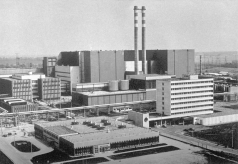 Paks
nuclear power plant. Staff from the U.S. Department of Energy's
Paks
nuclear power plant. Staff from the U.S. Department of Energy's
Argonne and Pacific Northwest national laboratories have supported analyses
of plant systems.
Pacific Northwest National Laboratory staff adapted the COBRA-SFS code for use in remodeling Paks' dry-storage system for spent nuclear fuel. The thermal-hydraulics code, developed by Pacific Northwest National Laboratory, predicts temperatures in a dry-storage system.
In December 1996, experts from Pacific Northwest National Laboratory trained Paks personnel to use the code. In May 1997, the United States provided the revised code to the Hungarian Atomic Energy Commission.
Soviet-designed plants have developed procedures for improved management and operational controls. In 1993, a working group began drafting guidelines for 16 procedures. The group was composed of representatives from host plants, US industry, the Institute of Nuclear Power Operations, and the Department of Energy.
Using the guidelines, Paks staff developed and implemented 14 site-specific procedures. The World Association of Nuclear Operators monitors progress in implementing the procedures at Soviet-designed plants and facilitates communication among the plants about lessons learned.
^top
Lithuania's Ignalina plant has the world's two largest operating nuclear reactors. The RBMK-1500s, originally designed to produce 1500 megawatts electricity, are currently rated to produce a maximum of 1380 megawatts of electricity. Together, they provided 73 percent of the electricity generated in Lithuania in 1999. Program activities cover the following areas:
- Emergency Operating Instructions
- Configuration Management
- Personnel Training
- Safety Maintenance Technologies
- Control-and-Protection Systems
- Code Validation
- Safety Analysis Capabilities
- Pressure Tube Analysis
- Safety Workshops
- Source Book Update
- Conduct of Operations
7.4.1 Emergency Operating Instructions
Symptom-based emergency operating instructions enable operators to take action to correct abnormal conditions without first having to determine the cause of the problem. The time saved can prevent disaster.
Ignalina developed a complete set of symptom-based instructions and plans to implement them in 2001. US and Swedish personnel provided technical support for developing the instructions. Staff from the Department of Energy and its Pacific Northwest National Laboratory provided technical support for the analysis phase of the project. The World Association of Nuclear Operators provided review and guidance for the development and implementation of the instructions.
7.4.2 Configuration Management
At Ignalina nuclear power plant, a multilateral project involving Sweden, Lithuania, and the United States developed and implemented a configuration management program. Configuration management involves collecting, archiving, and processing information about a facility, including data on design, requirements, equipment, specifications, and operations. The goal is to ensure the plant operates within its safety design basis.
Major project accomplishments include incorporating the configuration management software, called IFS Application, into plant administrative processes and training staff on approved implementing procedures. Related computer hardware was installed.
Plant specialists prepared Russian versions of software modules. The Chief Engineer ordered the process implemented and authorized configuration management of four business processes: 1) work order processing, 2) the master equipment register (master archive), 3) maintenance scheduling, and 4) purchasing and inventory.
The hard copy logbooks for the "old" processes have been retired, indicating a complete transfer to electronic processing and storage. A users group was established for the mutual benefit of three plants that are currently using the IFS Application software. These include Forsmark and Barsebeck plants in Sweden and Ignalina.
Delivery of the final set of computer equipment in 1999 completed US participation in the project.
The United States is working with the International Atomic Energy Agency to improve training at Ignalina. In May 1998, eight staff members from Ignalina traveled to the offices of General Physics Corporation in South Carolina, where they completed a four-week course in the Systematic Approach to Training. This methodology provides a standard framework for identifying training needs, analyzing jobs and their specific tasks, developing course materials based on these analyses, and using teaching methods that combine classroom instruction with hands-on equipment use.
In 1998 and 1999, Ignalina instructors completed two workshops with a US training specialist and a training specialist from the International Atomic Energy Agency. During the workshops, they developed a pilot training course for control room operators. The Ignalina instructors also developed a pilot course for simulator trainers. Both courses were completed and implemented in 1999.
7.4.4 Safety Maintenance Technologies
The United States provided up-to-date tools and training for maintenance workers to help reduce equipment malfunctions at Ignalina's RBMK reactors. RBMK reactors also are located at Ukraine's Chornobyl plant and Russia's Kursk, Leningrad, and Smolensk plants.
An RBMK reactor is susceptible to power instabilities. Inadequate maintenance can compound the hazards posed by this design flaw. US specialists have worked with RBMK managers to identify maintenance tools and training that will provide the greatest improvements in safety.
Pipe Lathe/Weld-Preparation Machines. In 1996, Ignalina requested and the United States delivered a pipe lathe/weld-preparation machine to repair corroded pipes. Technicians use pipe lathe/weld-preparation machines to cut pipes precisely and prepare them for welding. This improves weld integrity, reducing the risk of leaks that could cause loss of cooling water to the reactor core. Before receiving the equipment, workers cut pipes by hand. In July 1997, the United States shipped four additional pipe lathe/weld-preparation machines to Ignalina.
Valve-Seat Resurfacing Equipment. The United States delivered valve-seat resurfacing equipment to Ignalina in August 1997 and trained plant workers in its use. The equipment enables technicians to accurately repair leaking valves without having to remove them from pipes. This helps maintain the integrity of pipes, reducing the risk of leaks that could lead to a loss-of-coolant accident.
Vibration Monitoring and Shaft Alignment Systems. The United States delivered vibration monitoring and shaft alignment equipment to Ignalina in October 1997 and trained workers to use it. Technicians use the equipment to detect and correct imbalance and shaft misalignment in rotating machinery, such as pumps, motors, and turbines. For example, each RBMK reactor has nearly 2000 high-speed pumps, some of which supply cooling water to the reactor core. When a pump is misaligned or out of balance, its bearings and seals can fail, possibly leading to a loss-of-coolant accident.
Insulation Analysis Equipment. The United States delivered insulation analysis equipment to Ignalina in June 1998 and trained workers to use it. Technicians use the equipment to detect breakdown of the insulation around high-voltage lines and equipment, such as the transmission lines between site transformers and a plant's main generators.
Detecting and correcting insulation breakdown can prevent loss of power to key reactor systems. A risk analysis at Ignalina indicated that loss of power is the trigger most likely to lead to severe accidents at RBMK reactors. For example, loss of electrical power could shut down the reactor's cooling pumps, leading to rapid overheating of the reactor core
Training Facilities. With US funding, host-country workers in 1997 refurbished and equipped three rooms for training maintenance workers at Ignalina. The site previously lacked adequate facilities for these workers.
7.4.5 Control-and-Protection Systems
US and Ignalina specialists have worked together to increase the reliability of the plant's control-and-protection system. They have improved existing systems and created a completely new backup system. (For details, see box: Technology Transfer Improves Safety of Ignalina's Control-and-Protection System.)
Replacement Control Modules. Ignalina managers requested US support in replacing some of the plant's aging control-and-protection system modules. NUS Instruments, a subsidiary of U.S.-based Scientech, designed a replacement module with the same form, fit, and function as the original modules but using modern technology. NUS delivered 100 of the electronic modules in May 1998 after US and plant specialists performed quality assurance testing. Scientech and NUS Instruments worked with a Lithuanian company, the Electromagnetic Compatibility Scientific Research Center, to develop the ability to produce additional modules. The US specialists also worked with the company to establish a quality assurance program. In May 1997, company employees participated in quality assurance training at NUS headquarters in Idaho Falls, Idaho. The company completed production of 200 modules in December 1998.
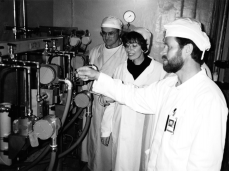 Ron
Wright, Pacific Northwest National Laboratory project manager (left); Zoya Voitenko,
translator; and Victor Sidnev, Unit 1 project manager inspect equipment for
monitoring pressure in the new control-and-protection system at the Ignalina
nuclear power plant.
Ron
Wright, Pacific Northwest National Laboratory project manager (left); Zoya Voitenko,
translator; and Victor Sidnev, Unit 1 project manager inspect equipment for
monitoring pressure in the new control-and-protection system at the Ignalina
nuclear power plant.
Backup Control-and-Protection System. During the 1998 outage at Ignalina Unit 1, plant workers installed an internationally designed and built backup control-and-protection system. The Lithuanian Nuclear Power Safety Inspectorate required that a new system be installed before the plant was restarted after the summer outage. An international team had performed a safety analysis of the plant that raised concerns about the existing system. The new system is built to strict international standards. Because it is independent of the original system, which remains in operation, the new system provides an additional measure of safety. With the installation completed in September, the plant was restarted and reached full-power operations in October 1998. With US support, Ignalina workers installed a similar backup control-and-protection system in Unit 2 to address the same concerns. Installation of the system in Unit 2 was completed in 1999.
|
Technology Transfer Improves Safety of Ignalina's Control-and-Protection System Nuclear power plants use electronic control-and-protection systems to monitor key reactor conditions, such as pressure, temperature, coolant flow, and neutron flux. If these conditions become abnormal, the control-and-protection system will shut down the reactor automatically. Plants typically have several "trains"-multiple control-and-protection systems, so that if one train malfunctions, others will be available to monitor and control the plant. Effective maintenance and repair also are essential. To facilitate maintenance, control-and-protection systems often are composed of dozens of electronic modules that can be replaced individually when they malfunction or become worn. The United States has supported two major improvements to the control-and-protection systems at Ignalina. First, NUS Instruments, a subsidiary of U.S.-based Scientech, manufactured replacement for the existing system. The failure rate of the existing modules was increasing and replacement parts were difficult to obtain. Engineers at a Lithuanian company worked with Scientech and NUS experts to gain the ability to manufacture more modules. The Electromagnetic Compatibility Scientific Research Center delivered the modules in September 1998. The Lithuanian company can now meet future needs for replacement modules at Ignalina and, potentially, at RBMK reactors in Russian and Ukraine. Second, during the 1998 outage at Ignalina Unit 1, plant workers installed an internationally designed and built backup control-and-protection system. The four-channel system meets strict nuclear standards. In a four-channel control-and-protection system, each channel gets a 'vote' on whether to let the plant operate. If two of the four channels vote to trip the reactor, the reactor is automatically shut down at once. But if one channel is defective and indicates a plant trip, it will not shut down the plant unnecessarily. The project was an intensive international team effort, funded by the United States and managed by the Pacific Northwest National Laboratory. Parsons Power provided management and engineering support, The Foxboro Company developed the detailed design of the logic system and supplied special logic cabinets, and Scientech working with the State Institute of Information Technology and the Lithuanian Energy Institute developed the safety review of the system. Ignalina plant staff managed system specifications, quality control, and installation in Ignalina Unit 1. |
STEPAN and NESTLE. Specialists use safety analysis codes to create a computer model of a reactor, simulate accidents, and calculate the reactor's ability to withstand abnormal conditions without damage to the fuel core.
When specialists use safety analysis codes, they must make sure the codes accurately represent and predict the configuration and behavior of the reactor being analyzed. In a process called validation, specialists check the codes against test data. These data are produced by experimental facilities designed to simulate the behavior of a specific type of reactor. In a process called verification, specialists use the safety analysis codes to develop plant models and accident scenarios, then check the models and scenarios against data from actual reactors.
Swedish and Russian specialists are assisting Lithuanian trainees in validating two neutron-kinetics codes for application to RBMK reactors in Lithuania and Russia. Specialists from the Royal Institute of Technology in Sweden are working with Russian specialists from the Kurchatov Institute to develop a methodology for validating the STEPAN and NESTLE codes. The specialists will develop benchmark problems in neutron-kinetics for RBMKs. They will analyze the problems using the Russian-developed STEPAN code and the U.S.-developed NESTLE code, then assist Lithuanian trainees in making code-to-code comparisons. The specialists agreed on the scope of the project in September 1998.
RELAP5. With US support, a Lithuanian graduate student at the University of Maryland has partially validated the RELAP5 computer code for use in safety analyses at Ignalina. RELAP5 is used to create a computer model of a particular reactor's thermal-hydraulic system, including the reactor core, the primary coolant system, and the steam drum separators. The code then uses the computer model to simulate accident scenarios and predict the progression of various emergencies involving the thermal-hydraulic system.
To partially validate the code, the Lithuanian specialist created a RELAP5 model of one of the plant's RBMK reactors. He then checked the model against data from the actual reactor to validate that the code's model and accident simulations accurately represent and predict the physical phenomena and event sequences in Ignalina's reactors. He completed his partial validation effort in June 1998 as part of his graduate thesis.
Because of complexities of the Ignalina RBMK reactor, the use of a three-dimensional version of the RELAP5 code that couples thermal-hydraulics with neutron-kinetics is often necessary. The US is providing training and guidance for the Lithuanian Energy Institute to develop and use a RELAP5-3D model for the plant.
SCALE. In 2000, a researcher from the Lithuanian Institute of Physics began a training program at Oak Ridge National Laboratory in the use of the SCALE code system for analyzing the criticality safety, shielding, and spent-fuel characterization of Ignalina facilities. The work, which was jointly funded by the National Nuclear Security Administration and the International Atomic Energy Agency, led to the calculation of accurate spent-fuel source terms for RBMK-1500 and RBMK-1000 reactor types. Source-term analyses of VVER-440 fuel were also performed as part of a multi-country code comparison and benchmarking task.
7.4.7 Safety Analysis Capabilities
The United States is providing computer hardware and training to improve the ability of Lithuanian specialists to perform safety analyses at the Ignalina plant. US experts also have worked with the specialists to create an International Nuclear Safety Center Internet site for Lithuania.
Experts from Argonne National Laboratory are working with personnel from Kaunas University of Technology in Vilnius, Lithuania, and staff from the Ignalina Safety Analysis Group at the Lithuanian Energy Institute.
In February 1998, the United States provided computers to Kaunas for use in safety analyses. In April 1998, two staff members from the Lithuanian Energy Institute completed a workshop on the use of two computer codes for assessing the structural safety of Ignalina's accident localization system. Personnel from Argonne provided training on the NEPTUNE and TEMP-STRESS codes, which were developed at Argonne National Laboratory. Argonne has worked with the Lithuanian Energy Institute to upgrade the NEPTUNE structural mechanics code for the analysis of pipe interactions in the event of a pipe break. The Lithuanian Energy Institute is using the new version of NEPTUNE to analyze the effect of whipping pipes on adjacent structures.
In 1998, US experts provided training in the use of NESTLE, a neutron-kinetics code, for staff from Kaunas Technical University and the Lithuanian Energy Institute.
Specialists at the Institute established an Internet site in 1998 for Lithuania's International Nuclear Safety Center (http://www.lei.lt/insc/). The website provides information on the Ignalina plant. It also provides access to the handbook for the Emergency Preparedness Organizations Around the Baltic Sea and to the Ignalina RBMK-1500 Source Book. The Source Book documents the plant's safety systems and describes the way plant components interact during normal and abnormal operating conditions. The Internet site will have a password-protected area for safety research collaborations
The website is similar to those of the US and Russian International Nuclear Safety Centers. (For more details on the US and Russian Safety Centers, see Section 6.5.2.)
US, Lithuanian, and Russian specialists have assessed the potential for the fuel-channel pressure tubes to fail in Ignalina's reactors during an accident. Using the ABAQUS and RELAP5 safety analysis codes, the specialists determined that the risk of pressure tube failure was negligible. They completed their report in June 1998.
Team members included specialists from Pacific Northwest National Laboratory, U.S.-based Scientech, the Lithuanian Energy Institute, Kaunas Technical University, and Russia's Kurchatov Institute.
US and host-country experts provided a series of workshops to improve the operational safety of nuclear power plants in Central and Eastern Europe. Ignalina hosted the second and third of these workshops. The topic of the April 1996 workshop was "Preventive and Predictive Maintenance in Nuclear Power Plant Operation." The topic of the May 1997 workshop was "Safety Culture in the Operation of Nuclear Power Plants."
With mentoring support from the University of Maryland, the Lithuanian Energy Institute updated the Ignalina RBMK-1500 Source Book. The book documents the plant's reactor and primary safety systems and describes the way plant components interact during normal and abnormal operating conditions. Changes made at Ignalina to improve safety prompted the update, which was completed in April 1998.
Soviet-designed plants have developed procedures for improved management and operational controls. Beginning in 1993, a working group began drafting guidelines for 16 procedures. The group was composed of representatives from host plants, US industry, the Institute of Nuclear Power Operations, and the Department of Energy.
Using the guidelines, Ignalina staff developed and implemented 16 site-specific procedures. The World Association of Nuclear Operators monitors progress in implementing the procedures at Soviet-designed plants and facilitates communication among the plants about lessons learned.
^top
Four operating reactors at the Bohunice nuclear power plant and two reactors at Mochovce provided 47 percent of the electricity generated in Slovakia in 1999. Two of the Bohunice reactors are VVER-440/230s; the other two are VVER-440/213s. The two operating reactors at Mochovce are VVER-440/213s. Two additional VVER-440/213 reactors are under construction at Mochovce, but their completion is unlikely. Program activities cover the following areas:
- Personnel Training
- Risk Advisory System
- Safety Analysis Capabilities
- Confinement Analysis Codes
- Information Exchanges
- Safety Culture Workshops
- Conduct of Operations
US training specialists are working with instructors at Slovakia's Trnava training center to improve training programs for nuclear power plant personnel. In July 1997, Trnava instructors traveled to the United States for a four-week course on the Systematic Approach to Training. This methodology provides a standard framework for identifying training needs, analyzing jobs and their specific tasks, developing course materials based on these analyses, and using teaching methods that combine classroom instruction with hands-on equipment use. In August 1997, US training specialists presented a simulator instructor course at Trnava.
With US support, the Trnava staff members are using the Systematic Approach to Training to develop courses for personnel at the Bohunice plant. In February 1998, they presented a pilot course on instruction skills. In 1999, US personnel worked with specialists from the Trnava training center and Bohunice to develop a pilot course for the plant's maintenance workers.
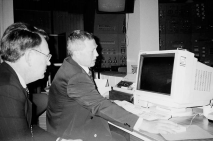 U.S.
specialists collaborated with VUJE to upgrade a personal computer-based training
simulator at Trnava training center.
U.S.
specialists collaborated with VUJE to upgrade a personal computer-based training
simulator at Trnava training center.
US personnel are working with host-country and European Community personnel to upgrade a full-scope training simulator at Trnava. The simulator replicates Bohunice's reactor Units 3 and 4, which are VVER-440/213s. In April 1998, Science Applications International Corporation shipped the new input-output system to Trnava. Staff from the Nuclear Power Plants Research Institute (VUJE) at Trnava received training in the operation and maintenance of the input-output system. Upgrades are under way for the reactor core and thermal-hydraulic models. The project is scheduled for completion in September 2001.
US personnel also collaborated with VUJE to upgrade a personal-computer-based training simulator at Trnava. The simulator replicates Units 1 and 2, which are VVER-440/230 reactors. To complete the project, US personnel delivered a user manual for the upgraded simulator in October 1997.
The United States has provided Bohunice with a three-year license to use R&R WORKSTATION, a computer analysis code for performing a probabilistic risk assessment. The code includes a software module for use as a risk advisory system. Science Applications International Corporation developed the computer code.
Bohunice staff members already have created a computer model of the plant's safety-related systems for use in a probabilistic risk assessment. After training in August 1998, Bohunice staff began incorporating this model into R&R WORKSTATION's risk advisory system.
Bohunice staff will use the risk advisory system to evaluate how the unavailability of certain plant components would affect the safety of plant operations. They will determine, for example, the risk the plant would face if a particular cooling-system pump failed or was out of service for maintenance. They then will use the system to quantify the risk that would be posed by the unavailability of each component. Maintenance managers will use the results to plan their preventive maintenance programs so that workers monitor more frequently the components that pose the highest risk.
7.5.3 Safety Analysis Capabilities
The United States has provided Slovakian specialists with computer hardware, software, and training to improve their ability to perform safety analyses at Bohunice's VVER-440/230 reactors.
The United States provided the ADAM computer code for nuclear accident diagnosis, analysis, and management. Energy Research Incorporated, a US company, developed the code and trained Slovakian specialists to use it. Staff from Bohunice, VUJE, and the Slovakian nuclear regulatory authority participated in the training.
In November 1998, personnel from the Slovakian nuclear regulatory authority, utilities, and VUJE participated in advanced training on the RELAP5 thermal-hydraulics code.
In 2000, Slovakian experts completed a project to develop a methodology to assess operator reliability at the Slovakian plant simulator. The human factor data collected will be used as part of the overall probabilistic risk assessment program in Slovakia.
|
"I would like to inform you that our system programmer has installed LINUX system as well as PC RELAP5 successfully and we have completed first calculations with RELAP5. Our work with RELAP5 is going on very well. Following our training program we should carry out first representative safety analyses with RELAP5 to the middle of February 1998. Many thanks for your cooperation and support." -Jan Husarcek |
7.5.4 Confinement Analysis Codes
Bohunice staff are defining ways to upgrade the confinement systems of the plant's two VVER-440/230 reactors. These reactors do not have air-tight containment systems. Their confinement structures are less effective than containment systems in preventing the release of radionuclides in an accident. The confinement buildings are not leak-tight and are designed to vent air to the atmosphere when pressure builds up inside, as is likely to occur during an accident.
In 1997, staff from Argonne National Laboratory worked with Slovakian specialists to adapt two confinement analysis codes, NEPTUNE and PACER, for use at VVER-440/230s. In June 1997, Argonne personnel trained Slovakian specialists to use the codes to analyze the effectiveness of proposed upgrades. This completed US contributions to the project.
The United States has sponsored international forums and workshops for exchanging information on in-depth safety assessments at Soviet-designed reactors. The International Atomic Energy Agency and the Swedish International Project on Nuclear Safety also have supported this effort.
Five forums focusing on analytical methods and computational tools for conducting assessments have been held. The first forum was in September 1996 in Obninsk, Russia. Representatives of 10 Soviet-designed nuclear power plants were among the 75 specialists attending from around the world. Forums have continued each year in Obninsk, in September 1997, and in October 1998, 1999, and 2000. The international forums now host more than 100 participants from a dozen countries.
Two smaller workshops have focused on probabilistic safety analyses at VVER reactors. Slovakia hosted an April 1997 workshop focused on improving a generic methodology for structuring and collecting data for plant-specific risk analyses. Participants from Russia, Ukraine, the Czech Republic, Hungary, Slovakia, Romania, Holland, and Spain attended.
7.5.6 Safety Culture Workshops
US and host-country instructors provided a series of workshops to improve the operational safety of nuclear power plants in Central and Eastern Europe. The Trnava training center hosted the first of these in January 1996. The topic was "Safety and Licensing Aspects of Plant Modifications and Engineering Support in the Operation of Nuclear Power Plants." The Slovak Nuclear Regulatory Authority hosted the fifth workshop in September 1998 in Bratislava. The topic was "Optimization of Resource Allocation Effectiveness in Controlling Risk in the Operation of Nuclear Power Plants."
Soviet-designed plants have developed procedures for improved management and operational controls. In 1993, a working group began drafting guidelines for 16 procedures. The group was composed of representatives from host plants, US industry, the Institute of Nuclear Power Operations, and the Department of Energy.
Using the guidelines, Bohunice staff developed and implemented 16 site-specific procedures. The World Association of Nuclear Operators monitors progress in implementing the procedures at Soviet-designed plants and facilitates communication among the plants about lessons learned.




